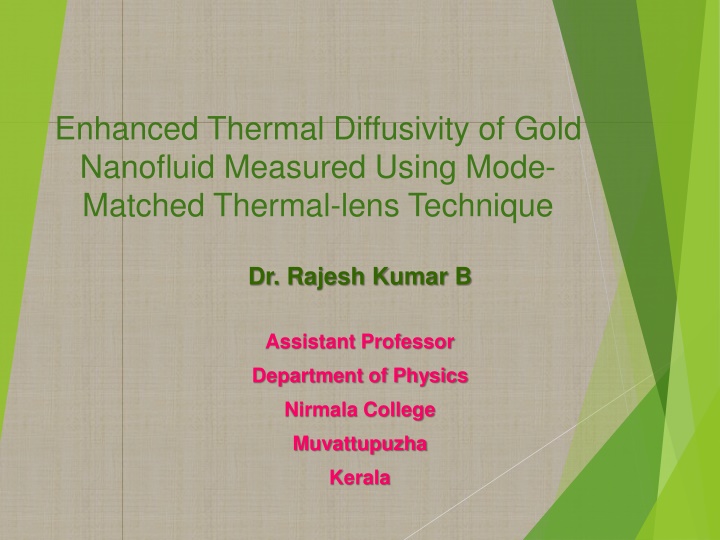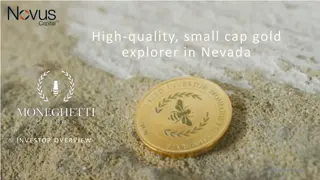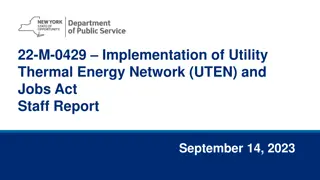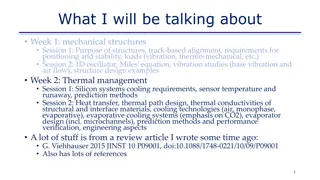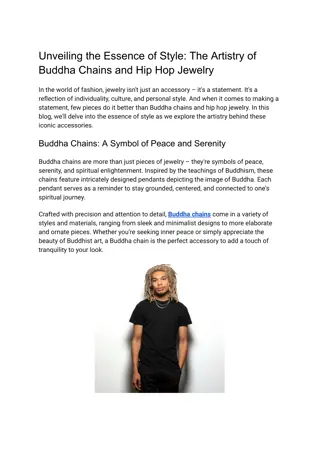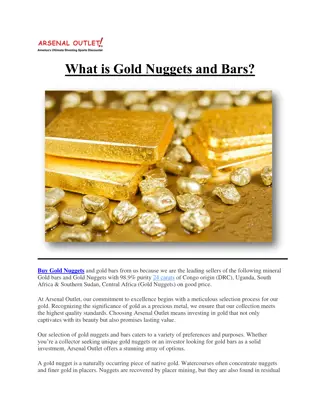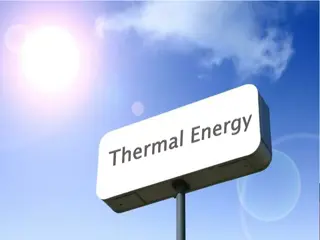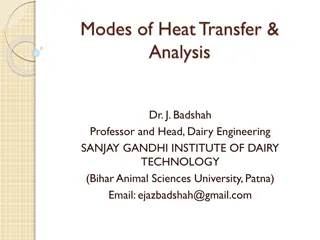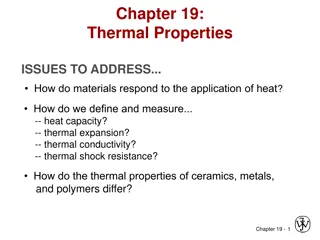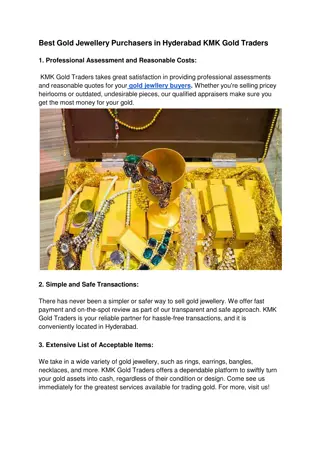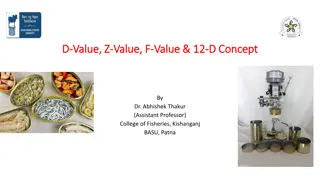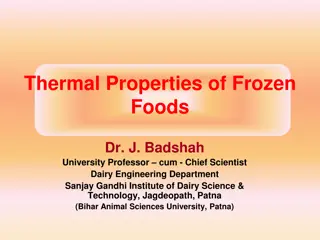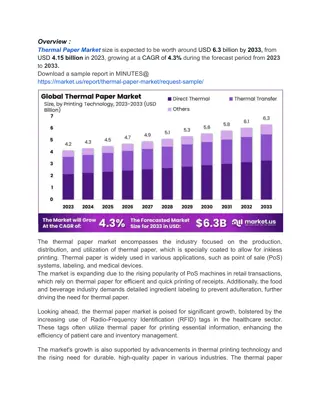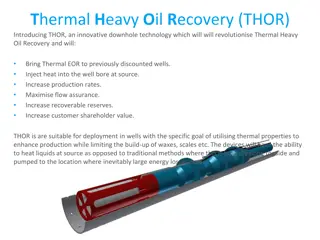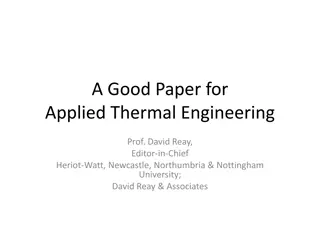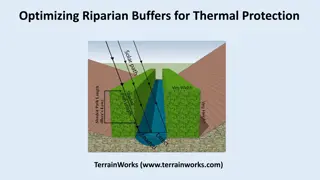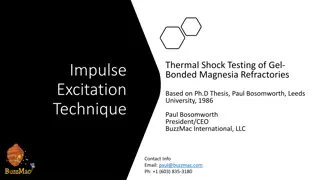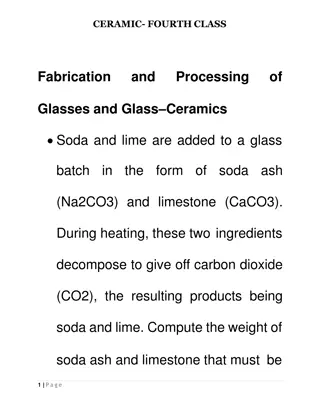Enhanced Thermal Diffusivity of Gold Nanofluid Measured Using Mode-Matched Thermal-lens Technique
This study by Dr. Rajesh Kumar B investigates the thermal diffusivity of gold nanofluid using advanced mode-matched thermal-lens technique. The research, conducted at Nirmala College in Kerala, sheds light on the enhanced thermal properties of gold nanoparticles in a fluid medium. The findings have implications for various fields including nanotechnology and thermal engineering.
Download Presentation

Please find below an Image/Link to download the presentation.
The content on the website is provided AS IS for your information and personal use only. It may not be sold, licensed, or shared on other websites without obtaining consent from the author.If you encounter any issues during the download, it is possible that the publisher has removed the file from their server.
You are allowed to download the files provided on this website for personal or commercial use, subject to the condition that they are used lawfully. All files are the property of their respective owners.
The content on the website is provided AS IS for your information and personal use only. It may not be sold, licensed, or shared on other websites without obtaining consent from the author.
E N D
Presentation Transcript
Enhanced Thermal Diffusivity of Gold Nanofluid Measured Using Mode- Matched Thermal-lens Technique Dr. Rajesh Kumar B Assistant Professor Department of Physics Nirmala College Muvattupuzha Kerala
Introduction Traditional heat transfer fluids such as water, oil and ethylene glycol are inherently poor heat transfer fluids. (thermal conductivity of water is 0.6 W/m K and for ethylene glycol 0.235 W/m K) In general, metals have high thermal conductivity (thermal conductivity of copper is 400 W/m K). Suspending solid fine particles into the base fluid is expected to enhance the thermal conductivity of that fluid The particles of micron size dimension suffer from sedimentation, fouling and clogging New technologies and new, advanced fluids with potential to improve thermal characteristics are of critical importance Nanofluids have a potential to reduce such problems EG-water mixture is widely used as a heat transfer fluid in, automobiles and heat exchangers Studied the effect of AuNP concentration on the thermal diffusivity values of mixtures, comprising ethylene glycol and an aqueous dispersion of AuNPs. Measurements are also carried out for the corresponding concentrations of gold nanofluids alone Thermal diffusivity is a material property which determines how fast heat diffuses through a material 2
Sample Preparation The mixture for the thermal diffusivity measurement is prepared by mixing equal amount of Au nanofluid and EG (50/50 volume ratio) In the mixture, concentration of the AuNP is varied from 0.7 to 3 nM, to study the influence of NP concentration on the thermal diffusivity value of the mixture 3
Thermal Diffusivity When the thermal lens develops in the medium, if a probe beam is allowed to pass through the thermal lens, the probe beam intensity decays according to the expression 1 1 ( ( ) ) ( ( ) ) ( ( ) ) t 1 2 2 = = + + + + + + I I 1 1 t t 2 1 t t 2 0 c c 2 dn = = P k th p dT The parameter tc is called the characteristic time for thermal diffusion given by 2 = = t c 4 k c p tc can be obtained by curve fitting the experimental data to the Equation (7) 5
Thermal Diffusivity The thermal diffusivity D of the unknown sample can be calculated using the expression 2 = = t / 4 D c In order to avoid the uncertainty in the measurement of beam radius, a reference sample, water, with known thermal diffusivity ( 1.43x10-7 m2/s) is used to calculate the thermal diffusivity of the unknown sample using the expression ref t c t D = = D ref c 6
TEM Studies TEM Image of AuNPs HRTEM Image of an individual AuNP. Inset shows the electron diffraction image of AUNP 7
Thermal Diffusivity Measurement The accuracy of the approach is measured by evaluating the thermal diffusivity value of the organic liquids, EG and ethanol. The measured thermal diffusivity values (0.917 0.005)x 10-7 m2 s-1 for EG and (0.801 0.005)x 10-7 m2 s-1 for ethanol, agrees well with the earlier reported values The thermal diffusivity value of EG- Thermal lens decay curve water mixture (50/50 volume ratio) is also measured (1.09 0.003)x 10-7 m2 s-1 8
In EG-Au nanofluid mixture the adsorbed charges are asymmetrically distributed on the surface of the particles These asymmetrically distributed charges will generate the dipole moment. Because of the dipole-dipole interaction, AuNPs will assemble once the thermal energy and the columbic repulsion are suppressed The integrative dipole moment of such assemblies of AuNPs will exert a stronger attractive force, therefore causing chain growth. Thus, the pre-formed chains facilitate the addition of free colloidal particles to the end of the chains via the dipole-dipole attraction Thermal diffusivity of (a)Au nanofluid alone and (b) Au nanofluid-EG mixture 9
There is no separate NP in the TEM image indicating that NPs in the mixture prefer to aggregate The probability of aggregation increases with density of particles (concentration) in the mixture, as it reduces the inter-particle distance As a consequence, AuNPs form linear or fractal configurations separated by large region of fluid pockets The formation longer chain like structures allows easy transport of thermal energy, which results in enhancement of thermal diffusivity values of the mixture compared to the gold nanofluids alone (a)TEM image and (b)HR-TEM image of AuNPs in Au nanofluid-EG mixture 10
Thermal diffusivity values of ethylene glycol-gold nanofluid mixture is measured using thermal-lens technique The transmission electron microscopy images of the gold nanoparticles in the mixture clearly indicate the formation of chain like aggregates Such a chain like structure allows easy transport of thermal energy, which results in an enhancement of thermal diffusivity values of the mixture as compared to the gold nanofluids alone Given the importance of ethylene glycol-water mixture as a commonly employed heat transferring fluid, the present study where in heat transferring capability is measured in terms of thermal diffusivity have greater significance and practical applicability 11
Thank You Thank You 12
